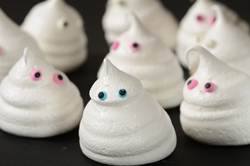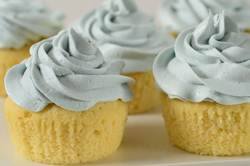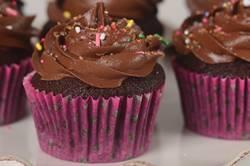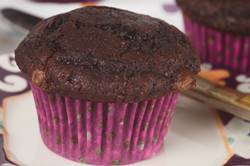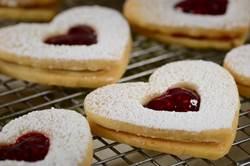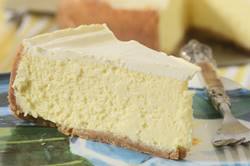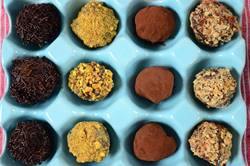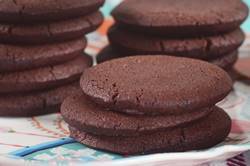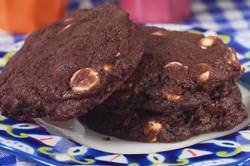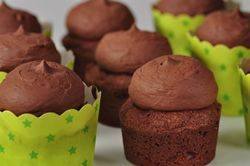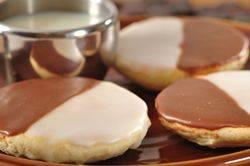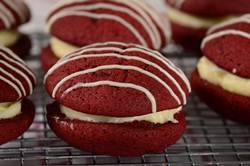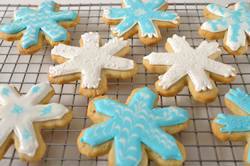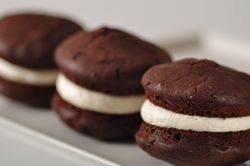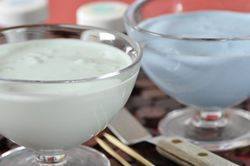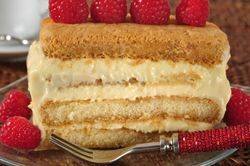jueves, 29 de septiembre de 2011
Meringue Ghosts
Meringue Ghosts Tested Recipe & Video
Printer Friendly Page
Meringue Ghosts are haphazard mounds of sweetened meringue studded with cute little candy eyes. Although it is obvious that children enjoy the look and taste of these ghosts, I find that adults are not immune to their charms. I love how the outside of the meringue ghosts are so light and crisp that they immediately dissolve on the tongue, while their insides are soft like a marshmallow, and oh so sweet. Serve these at your next Halloween gathering and watch them disappear.
If you look at this recipe and find yourself a little nervous about making a meringue, don't be. Meringue is simply a mixture of stiffly beaten egg whites and superfine (caster) sugar. The trick to making a good meringue is to get the egg whites to reach their maximum volume. This is achieved by first having your mixing bowl and whisk clean and free of grease. Next, you want to have the egg whites at room temperature. It is easier to separate the eggs while they are still cold, and once separated, cover the egg whites and let them come to room temperature before using (about 30 minutes). (Cover and refrigerate the egg yolks for another use.) Make sure that there are no little specks of egg yolk in the egg whites as this will prevent the whites from reaching their full volume when beaten. The recipe calls for superfine sugar which dissolves easier in the whites than regular granulated white sugar. Because superfine sugar can be hard to find in grocery stores, just make your own by taking 1 cup (200 grams) granulated white sugar and processing it in your food processor until very fine.
There are a few more things to keep in mind when making these meringue ghosts. The standard ratio when making meringues is 1/4 cup (50 grams) of sugar for every egg white and this amount of sugar is needed to give the meringue its crispness. Now you want to add the sugar gradually to the egg whites as this ensures that the sugar completely dissolves and does not produce a gritty meringue. Cream of tartar is also used in the whipping of egg whites to stabilize them, helps them to reach maximum volume, and prevents over beating. The meringue is ready when it forms stiff peaks (looks like marshmallow cream) and when you rub a little between your thumb and index finger it does not feel gritty. If it feels gritty the sugar has not fully dissolved so keep beating until it feels smooth between your fingers.
Once the meringue is made, the next step is to pipe the ghosts. I like to do this with a piping bag fitted with a 1/2 inch (1 cm) plain tip. When piping the ghosts, have the bag perpendicular to the parchment paper-lined baking sheet and, using even pressure, pipe about 2 inch (5 cm) high mounds of meringue. You can make the mounds any shape you want. Then carefully press two candy eyes (you can find candy eyes at cake decorating stores or you can order them online at http://www.candylandcrafts.com/) or two miniature chocolate chips or edible silver dragees into each mound and bake the meringue ghosts in a slow oven for about 1 - 1 1/2 hours or until they are crisp and dry to the touch. The slow oven allows for gradual evaporation of the moisture from the meringues. If you decide to make meringues on a rainy or humid day, you will probably have to bake the meringues longer (could be up to 30 minutes more).
Related Recipes You May Like
Halloween Chocolate Spiders
Halloween Whoopie Pies
Halloween Cheesecakes
Gingerbread Cookies
Candy Corn Parfaits
Halloween Cookies
Meringue Ghosts: Preheat oven to 200 degrees F (105 degrees C) and place the rack in the center of the oven. Line a baking sheet with parchment paper. Have ready a pastry bag fitted with a 1/2 inch (1.25 cm) plain tip.
In the bowl of your electric mixer, with the whisk attachment, beat the egg whites on low-medium speed until foamy. Add the cream of tartar and continue to beat the whites until they hold soft peaks. Add the sugar, a little at a time, and continue to beat until the meringue holds very stiff peaks. Beat in the vanilla extract.
Note: The meringue is done when it holds stiff peaks and when you rub a little between your thumb and index finger it does not feel gritty. If it feels gritty the sugar has not fully dissolved so keep beating until it feels smooth between your fingers.
Before placing the meringue ghosts on the cookie sheet, place a little of the meringue on the underside of each corner of the parchment paper. This will prevent the paper from sliding. Transfer the meringue to the pastry bag and, holding the bag perpendicular to the baking sheet, pipe, with even pressure, about 2 inch (5 cm) high mounds of meringue. Carefully press two candy eyes, edible silver dragees, or two miniature chocolate chips into each meringue ghost.
Bake the meringues for approximately 1 - 1 1/2 hours or until they are dry and crisp to the touch. Turn off the oven, open the door, and leave the meringues in the oven to finish drying several hours, or even overnight.
The Meringue Ghosts will keep several days at room temperature.
Makes 20-24 Meringue Ghosts
Sources:
Mead, Matthew. Matthew Mead's Monster Book of Halloween. Time Inc. New York: 2009.
Usher, Julia M. Cookie Swap. Gibbs Smith. Layton Utah: 2009.
http://www.101cookbooks.com/archives/spooky-ghost-meringues-recipe.html
Meringue Ghosts:
4 large egg whites (120 grams)
1/2 teaspoon cream of tartar
1 cup (200 grams) superfine or caster sugar (if you don't have superfine sugar simply take 1 cup (200 grams) granulated white sugar and process it for about 30 seconds in a food processor)
1/2 teaspoon pure vanilla extract
Candy eyes
Note: You can find candy eyes at cake decorating stores or you can order them online at http://www.candylandcrafts.com/.)
Note: Instead of candy eyes, you can use miniature chocolate chips.
Read more: http://www.joyofbaking.com/halloweenrecipes/MeringueGhosts.html#ixzz1ZNgNnGQ1
Vanilla Cupcakes
Vanilla Cupcakes: Preheat oven to 350 degrees F (177 degrees C) and line 12 muffin cups with paper liners.
In the bowl of your electric mixer, or with a hand mixer, beat the butter and sugar until light and fluffy. Add the eggs, one at a time, beating well after each addition. Beat in the vanilla extract.
In a separate bowl whisk together the lemon zest, flour, baking powder, and salt.
With the mixer on low speed, alternately add the flour mixture and milk, in three additions, beginning and ending with the flour. Scrape down the sides of the bowl as needed.
Evenly fill the muffin cups with the batter and bake for about 17 - 20 minutes or just until set and a toothpick inserted into a cupcake comes out clean. (Always check a few minutes before the stated baking time. Do not over bake or the cupcakes will be dry.) Remove from oven and place on a wire rack to cool. Once the cupcakes have completely cooled, frost with icing. If you want flat topped cupcakes then slice off the dome of each cupcake, with a sharp knife, before frosting. If you want to pipe the frosting, I like to use a large Wilton 1M star decorating tip. Cupcakes are best eaten the same day they are made, but they can be covered and stored for a few days.
Confectioners (Buttercream) Frosting: In an electric mixer, or with a hand mixer, cream the butter until smooth and well blended. Add the vanilla extract. With the mixer on low speed, gradually beat in the sugar. Scrape down the sides of the bowl. Add the milk and beat on high speed until frosting is light and fluffy (about 3-4 minutes). Add a little more milk or sugar, if needed. Tint the frosting with desired food color (I use the paste food coloring that is available at cake decorating stores and party stores).
Makes about 12 cupcakes
Source:
Hay, Donna. Modern Classics Book 2. Harper Collins Publishers Inc. New York: 2003.
Patent, Greg. Baking in America. Houghton Mifflin Company. New York: 2002.
Vanilla Cupcakes:
1/2 cup (113 grams) unsalted butter, room temperature
2/3 cup (130 grams) granulated white sugar
3 large eggs
1 teaspoon pure vanilla extract
Zest of 1 large lemon (outer yellow skin)
1 1/2 cups (195 grams) all purpose flour
1 1/2 teaspoons baking powder
1/4 teaspoon salt
1/4 cup (60 ml) milk
Confectioners (Buttercream) Frosting:
2 cups (230 grams) confectioners sugar (icing or powdered sugar), sifted
1/2 cup (113 grams) unsalted butter, room temperature
1 teaspoon pure vanilla extract
2 tablespoons milk or light cream
Assorted food colors (if desired)
Read more: http://www.joyofbaking.com/VanillaCupcakes.html#ixzz1ZNWBfJOu
Chocolate Cupcakes
Chocolate Cupcakes: Preheat oven to 375 degrees F (190 degrees C). Lightly butter, or line 16 muffin cups with paper liners.
In a small bowl stir until smooth the boiling hot water and the cocoa powder. Let cool to room temperature.
In another bowl, whisk together the flour, baking powder, and salt.
Then in the bowl of your electric mixer, or with a hand mixer, beat the butter and sugar until light and fluffy. Add the eggs, one at a time, beating until smooth. Scrape down the sides of the bowl as needed. Beat in the vanilla extract. Add the flour mixture and beat only until incorporated. Then add the cooled cocoa mixture and stir until smooth.
Fill each muffin cup about two-thirds full with batter and bake for about 16 - 20 minutes or until risen, springy to the touch, and a toothpick inserted into a cupcake comes out clean. (Do not over bake or the cupcakes will be dry.) Remove from oven and place on a wire rack to cool. Once the cupcakes have completely cooled, frost with icing. You can either spread the frosting on the cupcakes with a small spatula or if piping, use a large Wilton 1M open star tip to make lovely swirls. These cupcakes are best the day they are made, but can be covered and stored for a few days.
Chocolate Frosting: Melt the chocolate in a heatproof bowl placed over a saucepan of simmering water. Remove from heat and let cool to room temperature.
In the bowl of your electric mixer, or with a hand mixer, beat the butter until smooth and creamy (about 1 minute). Add the sugar and beat until it is light and fluffy (about 2 minutes). Beat in the vanilla extract. Add the chocolate and beat on low speed until incorporated. Increase the speed to medium-high and beat until frosting is smooth and glossy (about 2 -3 minutes).
Makes about 16 cupcakes.
Sources:
Bell, Annie. 'Gorgeous Cakes'. Kyle Books. Distributed by National Book Network. Lanham, MD: 2005.
Lewis, Matt & Nelson, Alison. 'Chocolate Bar'. Stonesong Press. New York: 2004.
Chocolate Cupcakes:
1/2 cup (50 grams) Dutch-processed cocoa powder
1 cup (240 ml) boiling hot water
1 1/3 cups (175 grams) all purpose flour
2 teaspoons baking powder
1/4 teaspoon salt
1/2 cup (113 grams) unsalted butter, room temperature
1 cup (200 grams) granulated white sugar
2 large eggs
2 teaspoons pure vanilla extract
Chocolate Fudge Frosting:
4 ounces (120 grams) unsweetened chocolate, coarsely chopped
2/3 cup (150 grams) unsalted butter, room temperature
1 1/3 cups (160 grams) confectioners (powdered or icing) sugar, sifted
1 1/2 teaspoons pure vanilla extract
Read more: http://www.joyofbaking.com/ChocolateCupcakes.html#ixzz1ZNV9DCSx
Alfajores
Dulce de Leche: Put the milk, sugar, corn syrup, baking soda and salt in a heavy-duty 8 quart (8 liter) saucepan or Dutch oven. Place over medium-high heat and bring just to a boil. Watch carefully, and as soon as the milk begins to foam up, stir with a heatproof spatula or wooden spoon, and reduce heat until the milk is just at a low rolling boil. Continue to cook the milk, stirring the bottom and sides of the saucepan frequently, until the mixture becomes very thick and sticky and caramel colored (this will take about 40 - 60 minutes). It is important to frequently stir the milk so it does not burn.
Dulce de Leche Video
Note: There are several stages the milk goes through during the cooking process. When the milk first comes to a boil there is a lot of foam. Eventually the foam subsides and after about 15 minutes, the milk turns a light beige color. As it continues to cook, the milk thickens and gets darker in color. Once the Dulce de Leche has been reduced to about 1 1/4 cups (300 ml) remove from heat and strain. Stir in the vanilla extract. Let cool before covering and storing. The Dulce de Leche can be stored in the fridge for a month.
Shortbreads: In a separate bowl whisk the flour with the salt. In the bowl of your electric mixer (or with a hand mixer), beat the butter until smooth and creamy. Add the sugar and beat until smooth. Beat in the vanilla extract. Gently beat in the flour mixture just until incorporated. Flatten the dough into a disk shape, wrap in plastic wrap, and chill the dough for at least an hour or until firm.
Shortbread Cookies Video
Preheat oven to 350 degrees F (177 degrees C) with the rack in the middle of the oven. Line two baking sheets with parchment paper.
On a lightly floured surface roll out the dough until it is about 1/4 inch (.6 cm) thick. Using a lightly floured 2 inch (5 cm) round cookie cutter, cut out rounds. Place on the baking sheets and place in the fridge for about 15 minutes. (This will firm the cookies so they maintain their shape when baked.) Bake for about 7 - 10 minutes, or until cookies are brown around the edges. Cool on a wire rack. Shortbread cookies with keep in an airtight container for about a week.
Alfajores: Take two shortbread cookies and sandwich them together with a heaping teaspoon of Dulce de Leche. Sprinkle the tops of the cookies with confectioners sugar. Can be covered and stored for a few days in the refrigerator.
Makes about 24 Alfajores cookies.
Dulce de Leche:
4 cups (1 quart) (1 liter) whole milk (cow's or goat's milk)
3/4 cup (150 grams) granulated white sugar
2 tablespoons light corn syrup
1/2 teaspoon baking soda
1/8 teaspoon salt
1 teaspoon pure vanilla extract
Shortbread Cookies:
2 cups (260 grams) all-purpose flour
1/4 teaspoon salt
1 cup (2 sticks) (226 grams) unsalted butter, room temperature
1/2 cup (60 grams) confectioners (powdered or icing) sugar
1 teaspoon pure vanilla extract
Read more: http://www.joyofbaking.com/shortbreads/AlfajoresRecipe.html#ixzz1ZNUmWzCo
Chocolate Muffins Tested
Chocolate Muffins: Preheat oven to 375 degrees F (190 degrees C). Position rack in center of oven. Butter, or line with paper liners, 12 - 2 3/4 x 1 1/2 inch muffin cups.
In a large measuring cup or bowl whisk together the melted butter, eggs, buttermilk, and vanilla extract.
In another large bowl whisk together the flour, cocoa powder, sugar, baking powder, baking soda, and salt. Stir in the chocolate chips. With a rubber spatula fold the wet ingredients into the dry ingredients and stir only until the ingredients are combined. Do not over mix the batter or tough muffins will result.
Evenly fill the muffin cups with the batter (the muffin cups will be full), using two spoons or an ice cream scoop. Place in the oven and bake until a toothpick inserted in the center of a muffin comes out clean, about 20 minutes. Transfer to a wire rack and let cool for about 5 minutes before removing from pan.
Chocolate Frosting: Melt the chocolate in a heatproof bowl placed over a saucepan of simmering water. Remove from heat and let cool to room temperature.
In the bowl of your electric mixer, or with a hand mixer, beat the butter until smooth and creamy (about 1 minute). Add the sugar and beat until it is light and fluffy (about 2 minutes). Beat in the vanilla extract. Add the chocolate and beat on low speed until incorporated. Increase the speed to medium-high and beat until frosting is smooth and glossy (about 2 -3 minutes). Spread a little frosting on each muffin with a knife or offset spatula.
Makes 12 - 14 regular sized muffins.
Source:
King Arthur Flour, The King Arthur Flour Baker's Companion. The Countryman Press. Woodstock: 2003.
Chocolate Muffins:
1/2 cup (113 grams) unsalted butter, melted and cooled
2 large eggs
1 cup (240 ml) buttermilk
2 teaspoons pure vanilla extract
1 3/4 cups (230 grams) all-purpose flour
2/3 cup (60 grams) unsweetened cocoa powder
1 1/4 cups (265 grams) light brown sugar
1 teaspoon baking powder
1 teaspoon baking soda
1/2 teaspoon salt
1 cup (170 grams) milk or semisweet chocolate chips
Chocolate Fudge Frosting: (optional)
4 ounces (120 grams) unsweetened chocolate, coarsely chopped
2/3 cup (150 grams) unsalted butter, room temperature
1 1/3 cups (160 grams) confectioners (powdered or icing) sugar, sifted
1 1/2 teaspoons pure vanilla extract
Read more: http://www.joyofbaking.com/muffins/ChocolateMuffins.html#ixzz1ZNUeI946
Raspberry White Chocolate Shortbreads
Shortbreads: In a separate bowl whisk the flour with the salt.
In the bowl of your electric mixer (or with a hand mixer), beat the butter until smooth (about 1 minute). Add the sugar and beat until smooth (about 2 minutes). Beat in the vanilla extract. Gently stir in the flour mixture just until incorporated. Flatten the dough into a disk shape, wrap in plastic wrap, and chill the dough for at least an hour.
Preheat oven to 350 degrees F (177 degrees C) with the rack in the middle of the oven. Line two baking sheets with parchment paper.
On a lightly floured surface roll out the dough until it is about 1/4 inch (1 cm) thick. Using a 2 to 3 inch (5 to 7.5 cm) cookie cutter (round, square, heart, etc.) cut out the dough. Place the cookies about 1 inch (2.5 cm) apart on the prepared baking sheets. Use a smaller cookie cutter (3/4 - 1 inch (2.5 cm)) to cut out the centers of half of the cookies on the baking sheet. (You will be sandwiching two cookies together and there will be a small 'window or cut out' in the top cookie so you can see the jam underneath.) Place the unbaked cookies, on the baking sheet, in the refrigerator for about 15 minutes. This will firm up the dough so the cookies will maintain their shape when baked. Bake for about 10 minutes, or until cookies are lightly browned. Cool on a wire rack.
To Assemble Cookies: Place the cookies with the cut-outs on a wire rack and dust the tops with the confectioners' (powdered or icing) sugar.
On the bottom surface of the full cookie (top of cookie will face out) spread with about a 1/4 - 1/2 teaspoon of jam. Sprinkle with a little grated white chocolate. Place the cut-out cookie on top and gently sandwich them together, making sure not to smug the confectioners' sugar. Using a small spoon, fill the cut-out with a little more jam.
Makes about 12 sandwich cookies.
Note: You can store the unassembled cookies for several days in an airtight container. It is best, though, to assemble the cookies the same day as serving in order to keep the cookies crisp.
Homemade Raspberry Preserves: Place the frozen unsweetened raspberries and the sugar in a small saucepan and bring to a boil over medium heat. Reduce the heat and simmer, stirring occasionally, for about 20 minutes or until most of the liquid has evaporated. Do not let it burn. Remove from heat and pour into a heatproof measuring cup. You should have almost a cup of preserves. Add a drop or two of lemon juice. Cover and place in the refrigerator for a few days before using.
Source:
Johnson, Jann. Shortbread. Chronicle Books. San Francisco. 1997.
Shortbreads:
2 cups (260 grams) all-purpose flour
1/4 teaspoon salt
1 cup (226 grams) unsalted butter, room temperature
1/2 cup (60 grams) powdered (confectioners or icing) sugar
1 teaspoon pure vanilla extract
Filling:
1/4 - 1/2 cup of raspberry jam or homemade raspberry preserves
2 ounces (60 grams) white chocolate, grated
Homemade Raspberry Preserves: (optional)
2 cups (225 grams) (8 ounces) frozen raspberries, unsweetened
1/4 cup (50 grams) granulated white sugar
a few drops of fresh lemon juice
Read more: http://www.joyofbaking.com/shortbreads/RaspberryWhiteChocolateShortbreads.html#ixzz1ZNUNRXmO
New York Cheesecake
New York Cheesecake: Grease, or spray with Pam, a 9 inch (23 cm) springform pan. Place the springform pan on a larger baking pan to catch any leakage while the cheesecake is baking. Preheat oven to 350 degrees F (177 degrees C) with rack in center of oven.
For Crust: In a medium sized bowl combine the graham cracker crumbs, sugar, and melted butter. Press the crumbs evenly over the bottom and about 1 inch (2.5 cm) up the sides of the springform pan. Cover and refrigerate while you make the filling.
For Filling: In bowl of your electric mixer place the cream cheese, sugar, and flour. Beat on medium speed until smooth (about 2 minutes), scraping down the bowl as needed. Add the eggs, one at a time, beating well (about 30 seconds) after each addition. Scrape down the sides of the bowl. Add the whipping cream, lemon zest, vanilla extract and beat until incorporated. Remove the crust from the refrigerator and pour in the filling. Place the cheesecake pan on a larger baking pan and place in the oven.
Bake for 15 minutes and then lower the oven temperature to 250 degrees F (120 degrees C) and continue to bake for about another 60 - 90 minutes or until firm and only the center of the cheesecake looks a little wet and wobbly. (The baking time can vary due to the differences in ovens, so make sure to check that the cheesecake is firm with only the center being a little wet and wobbly.) Remove from oven and place on a wire rack.
Meanwhile, in a small bowl combine the sour cream, sugar, and vanilla extract. Spread the topping over the warm cheesecake and return to oven to bake for 15 more minutes. Remove from oven and carefully run a knife or spatula around the inside edge of pan to loosen the cheesecake (helps prevent the surface from cracking as it cools).
Let cool completely before covering with plastic wrap. Refrigerate several hours, preferably overnight. Serve with fresh fruit or fruit sauces.
Makes one - 9 inch (23 cm) cheesecake.
To freeze: Place the cooled cheesecake on a baking pan and freeze, uncovered, until firm. Then wrap in aluminum foil and place in a freezer bag. Seal and return to freezer. Can be frozen for several months. Thaw uncovered cheesecake in the refrigerator overnight.
Adapted from Cheesecake Extraordinaire by Mary Crownover.
Crust:
2 cups (200 grams) of graham cracker crumbs or finely crushed Digestive biscuits
1/4 cup (50 grams) granulated white sugar
1/2 cup (114 grams) unsalted butter, melted
Filling:
32 ounces (1 kg) cream cheese, room temperature (use full fat, not reduced or fat free cream cheese)
1 cup (200 grams) granulated white sugar
3 tablespoons (35 grams) all purpose flour
5 large eggs, room temperature
1/3 cup (80 ml) heavy whipping cream (double cream)
1 tablespoon lemon zest
1 teaspoon pure vanilla extract
Topping:
1 cup (240 ml) sour cream (not low fat or fat free)
2 tablespoons (30 grams) granulated white sugar
1/2 teaspoon pure vanilla extract
Tips: Sometimes the surface of the cheesecake cracks. To help prevent this from happening do not over beat the batter, especially when creaming the cheese and sugar.
Another reason for cracking is overbaking the cheesecake. Your cheesecake is done when it is firm but the middle may still look a little wet.
Also, make sure the springform pan is well greased as cracking can occur if the cheesecake sticks to the sides as it cools.
Read more: http://www.joyofbaking.com/Cheesecake.html#ixzz1ZNTiptrZ
Chocolate Truffles
Chocolate Truffles: Place the chopped chocolate in a medium sized heatproof bowl. Set aside. Heat the cream and butter in a small saucepan over medium heat. Bring just to a boil. Immediately pour the boiling cream over the chocolate and allow to stand for a minute or two. Stir with a rubber spatula until smooth. (If the chocolate doesn't melt completely, place in the microwave for about 20 seconds, or over a saucepan of simmering water, just until melted.) If desired, add the liqueur. Cover and place in the refrigerator until the truffle mixture is firm (this will take several hours or overnight).
Place your coatings for the truffles on a plate. Remove the truffle mixture from the refrigerator. With your hands, a small ice cream scoop, a melon baller, or a small spoon form the chocolate into round or mis-shaped bite-sized balls. Immediately roll the truffle in the coating and place on a parchment lined baking sheet or tray. Cover and place in the refrigerator until firm. Truffles can be refrigerated for a couple of weeks or else frozen for a couple of months. Bring to room temperature before serving.
Makes 30 small truffles.
To Toast Nuts: Preheat oven to 350 degrees F (177 degrees C) and bake nuts (pecans, walnuts or almonds) about 8 - 10 minutes or until brown and fragrant. For hazelnuts toast about 15 minutes or until the skins start to blister. Remove from oven and roll in a clean dish towel. Let the nuts 'steam' for about 5 minutes and then remove the skins. Once the nuts have cooled, chop coarsely.
Sources:
Bloom, Carole. 'Truffles, Candies, & Confections'. The Crossing Press. Freedom, CA: 1992.
Yard, Sherry. 'The Secrets of Baking'. Houghton Mifflin Company. New York: 2003.
Chocolate Truffles:
8 ounces (227 grams) semisweet or bittersweet chocolate, cut into small pieces
1/2 cup (120 ml) heavy whipping cream (double cream) (35-40% butterfat)
2 tablespoons (28 grams) unsalted butter, cut into small pieces
2 tablespoons alcohol (Cognac, brandy, Grand Marnier, kirsch, rum, bourbon, or Kahlua to name a few) (optional)
Different Coatings for Truffles:
Dutch-Processed Cocoa Powder
Melted or Tempered Chocolate
Confectioners Sugar (Icing or Powdered)
Toasted and Chopped Nuts (pecans, walnuts, almonds, hazelnuts)
Toasted Coconut
Shaved Chocolate
Read more: http://www.joyofbaking.com/ChocolateTruffles.html#ixzz1ZNTX4dWl
Chocolate Wafers
Chocolate Wafers: In a bowl, sift or whisk together the flour, cocoa powder, baking soda, and salt.
In the bowl of your electric mixer (or with a hand mixer), beat the butter and margarine until well blended. Add the sugars and vanilla extract and beat on high speed for about one minute. Scrape down the sides of the bowl. Beat in the egg white. Add the flour mixture and beat just until incorporated.
Place the dough on your counter and, using your hands, evenly form the dough into a log shape that is about 9 inches (23 cm) long. Carefully wrap the dough in aluminum foil, parchment paper or wax paper and fold or twist the ends. Try not to flatten the log. Refrigerate until firm. This will take several hours or you can even chill it overnight.
Preheat the oven to 350 degrees F (177 degrees C) and place the oven rack in the center of the oven. Line two baking sheets with parchment paper.
Using a sharp knife, slice the log into about 1/4 inch (6 mm) thick wafers. Place the wafers on the baking sheet spacing, about 1 inch (2.5 cm) apart. Bake for approximately 10 - 12 minutes or until the the cookies puff and the tops of the cookies have cracks (ripples). Remove from oven and let the cookies cool on the baking sheet for about 5 minutes before removing to a wire rack to cool completely. Can be stored in an airtight container, at room temperature, for about 10 days. They can also be frozen.
Makes about 36 cookies.
Adapted from:
Medrich, Alice. Cookies and Brownies. Warner Books, Inc.. New York: 1999.
Chocolate Wafers:
1 cup (130 grams) all purpose flour
1/2 cup (50 grams) unsweetened cocoa powder (regular or Dutch-processed)
1/4 teaspoon baking soda
1/4 teaspoon salt
3 tablespoons (45 grams) unsalted butter, room temperature
3 tablespoons (45 grams) margarine (or Smart Balance)
2/3 cup (140 grams) packed light brown sugar
1/2 cup (100 grams) white granulated sugar
1 teaspoon pure vanilla extract
1 large (30 grams) egg white
Read more: http://www.joyofbaking.com/ChocolateWafers.html#ixzz1ZNSsdWza
Chocolate Cookies
Chocolate Cookies: Preheat oven to 350 degrees F (177 degrees C) and place rack in center of oven. Line two baking sheets with parchment paper.
In the bowl of your electric mixer (or with a hand mixer), beat the butter and sugars until light and fluffy (2-3 minutes). Add the egg and vanilla extract and beat until incorporated. First sift together the cocoa powder, flour, baking powder, and salt and then add to the butter and egg mixture. Mix just until incorporated. Fold in the the chocolate chips.
Using a small ice cream scoop or two spoons, place about 1 1/2 tablespoons of batter on the prepared baking sheet, spacing about 2 inches (5 cm) apart.
Bake for approximately 8 - 10 minutes or until the the cookies are still soft in the center but are firm around the edges. Remove from oven and let cookies cool on baking sheet for about 5 minutes before removing the cookies to a wire rack to cool completely.
Makes about 24 - 3 inch round cookies.
Chocolate Cookies:
1/2 cup (113 grams) unsalted butter, room temperature
1/2 cup (105 grams) light brown sugar
1/4 cup (50 grams) white granulated sugar
1 large egg
1 teaspoon pure vanilla extract
1 cup (130 grams) all purpose flour
1/4 cup (30 grams) Dutch-processed cocoa powder
1/2 teaspoon baking powder
1/8 teaspoon salt
1 1/2 cups (260 grams) white chocolate chips or chunks
Read more: http://www.joyofbaking.com/ChocolateCookies.html#ixzz1ZNSh234i
Brownie Cupcakes
Brownie Cupcakes: Preheat oven to 325 degrees F (170 degrees C) and place rack in center of oven. Line 12 muffin tins with paper or foil baking cups.
Melt the chopped chocolate and butter in a stainless steel bowl placed over a saucepan of simmering water. Once the chocolate is melted and smooth, remove from heat and let cool for a few minutes. Then stir (can also use a hand mixer) in the sugar. Add the vanilla and then add the eggs, one at a time, mixing well after each addition. Mix in the flour and salt until well blended.
Evenly divide the batter between the muffin cups. Place in the preheated oven and bake for about 20 - 25 minutes or until a toothpick inserted in the center of a cupcake has moist crumbs. Remove from oven and let cool on a wire rack. Once the cupcakes have completely cooled, frost with icing. You can either spread the frosting on the cupcakes with a small spatula or if piping, using a large Wilton plain, or open or closed star tip.
Chocolate Frosting: Melt the chocolate in a heatproof bowl placed over a saucepan of simmering water. Remove from heat and let cool to room temperature.
In the bowl of your electric mixer, or with a hand mixer, beat the butter until smooth and creamy (about 1 minute). Add the sugar and beat until it is light and fluffy (about 2 minutes). Beat in the vanilla extract. Add the chocolate and beat on low speed until incorporated. Increase the speed to medium-high and beat until frosting is smooth and glossy (about 2 -3 minutes).
Makes 12 cupcakes.
Sources:
Lewis, Matt & Nelson, Alison. 'Chocolate Bar'. Stonesong Press. New York: 2004.
Rosenberg, Judy. 'All-Butter Fresh Cream Sugar- Packed No-Holds-Barred Baking Book'. Workman Publishing. New York: 1991.
Brownie Cupcakes:
4 ounces (120 grams) unsweetened chocolate, chopped
1/2 cup (113 grams) unsalted butter, cut into pieces
1 1/4 cup (250 grams) granulated white sugar
1 teaspoon pure vanilla extract
3 large eggs
3/4 cup (95 grams) all purpose flour
1/4 teaspoon salt
Chocolate Fudge Frosting:
4 ounces (120 grams) unsweetened chocolate, coarsely chopped
2/3 cup (150 grams) unsalted butter, room temperature
1 1/3 cups (160 grams) confectioners (powdered or icing) sugar, sifted
1 1/2 teaspoons pure vanilla extract
Read more: http://www.joyofbaking.com/BrownieCupcakes.html#ixzz1ZNSXXQDR
Black and White Cookies
Black and White Cookies: Preheat oven to 375 degrees F (190 degrees C) and place rack in center of oven. Line two baking sheets with parchment paper.
In a large bowl whisk together the flours, baking powder, and salt.
In the bowl of your electric mixer (or with a hand mixer), beat the butter and sugar until fluffy. Add the eggs, one at a time, beating well after each addition. Beat in the vanilla extract and lemon extract. Scrap down the sides of the bowl as needed.
With the mixer on low speed, alternately add the flour mixture and milk, in three additions, beginning and ending with the flour.
Using a 1/4 cup (60 ml) measuring cup, place mounds of batter on the prepared baking sheet. Then, using an offset spatula or the blade of a knife, spread the batter into a 2 1/2 inch (6.5 cm) round. Space the cookies at least 3 inches (7.25 cm) apart. Bake the cookies for about 15 - 18 minutes, or until the edges and bottoms of the cookies are lightly browned and a toothpick inserted in the center comes out clean. Remove from oven and cool on a wire rack.
Frosting: Place the confectioners sugar in a large bowl. Gradually stir in the hot water, corn syrup, and vanilla extract, stirring constantly, until the mixture is thick, smooth, and of spreading consistency. Add more sugar or water if necessary to get the right consistency.
Remove about 1/2 cup (120 ml) of the frosting and place it in another heatproof bowl. Add the finely chopped chocolate. Place the bowl over a saucepan of simmering water until the chocolate has melted and the frosting is smooth. Remove from heat.
Turn the cookies so the flat bottoms are facing up. Spoon about 1 tablespoon of the white icing on one half of each cookie. Then, using a small offset spatula or knife, spread the frosting evenly over half the cookie. Tilt the cookie and run the spatula along the edge of the cookie to scrape off excess frosting. Place the cookie on a wire rack. Repeat with the remaining cookies. If the frosting thickens too much, add a few drops of water.
Once all the cookies are covered with the white frosting, then cover the bare half of each cookie with the chocolate frosting. If the chocolate frosting becomes too thick, reheat over the simmering water until fluid. Add a little hot water to thin the frosting if necessary.
Makes about 24 large cookies.
Sources:
Klivans, Elinor. Big Fat Cookies. Chronicle Books. San Francisco: 2005.
O'Neill. Molly. New York Cookbook. Workman Publishing Company, Inc. New York: 1992.
http://www.nytimes.com/1998/05/13/dining/look-to-the-cookie-an-ode-in-black-and-white.html?scp=279&sq=cookie+recipes&st=nyt
Black and White Cookies:
2 1/2 cups (325 grams) all purpose flour
2 1/2 cups (290 grams) cake flour
1 teaspoon baking powder
1/2 teaspoon salt
1 cup (226 grams) unsalted butter, room temperature
1 3/4 cups (350 grams) granulated white sugar
4 large eggs
1/2 teaspoon pure vanilla extract
1/4 teaspoon pure lemon extract
1/2 cup (120 ml) milk
Glaze:
4 cups (460 grams) confectioners sugar (powdered or icing sugar)
1/3 - 1/2 cup (80 - 120 ml) hot water
2 tablespoons light corn syrup
1/2 teaspoon pure vanilla extract
1 ounce (30 grams) bittersweet or semi-sweet chocolate, finely chopped
Read more: http://www.joyofbaking.com/BlackAndWhiteCookies.html#ixzz1ZNSHsqAy
Red Velvet Whoopie Pies
Red Velvet Whoopie Pies: Preheat oven to 375 degrees F (190 degrees C) and place oven rack in the center of the oven. Line two baking sheets with parchment paper.
In a large bowl sift together the flour, cocoa powder, baking powder, baking soda, and salt.
In the bowl of your electric mixer, fitted with the paddle attachment (can also use a hand mixer), beat the butter and sugars until light and fluffy. Add the egg beating well. Beat in the vanilla extract. In a small measuring cup, mix the buttermilk and red food coloring. With the mixer on low speed, alternately add the flour mixture and buttermilk mixture, in three additions, beginning and ending with the flour. Drop heaping tablespoons (can also use a small ice cream scoop) of the batter onto the prepared baking sheets, spacing about 2 inches (5 cm) apart. With moistened fingers or with the back of a spoon, smooth the tops of the cookies.
Bake for about 9-10 minutes or until the tops of the cookies, when lightly pressed, spring back (or a toothpick inserted into the center of a cookie comes out clean). Remove from oven and transfer to a wire rack to cool completely.
Cream Cheese Filling: Beat the butter until smooth and creamy. Add the cream cheese and beat until smooth. Beat in the vanilla extract. With the mixer on low speed, gradually beat in the confectioners' sugar, and continue to beat until smooth and creamy.
To Assemble: Take one cookie and spread a heaping tablespoon of the filling on the flat side of the cookie. Top with another cookie. If desired, take a little of the filling and thin it out, to piping consistency, with a little milk or cream. Place in a small piping bag or plastic bag and pipe lines back and forth over the tops of the Whoopie Pies. The assembled cookies can be stored, covered, in the refrigerator for several days.
Makes about 17 sandwich cookies.
Sources:
Baggett, Nancy. All-American Cookie Book. Houghton Mifflin Company. New York: 2001.
Brachman, Wayne Harley. American Desserts. Clarkson Potter/Publishers. New York: 2003.
Lewis, Matt & Poliafito, Renato. Baked Explorations. Stewart, Tabori & Chang. New York: 2010.
Red Velvet Whoopie Pies:
2 1/4 cups (295 grams) all purpose flour
1/4 cup (30 grams) Dutch-processed cocoa powder (can use regular unsweetened)
1/2 teaspoon baking powder
1/2 teaspoon baking soda
1/4 teaspoon salt
3/4 cup (170 grams) unsalted butter, room temperature
1 cup (200 grams) granulated white sugar
1 large egg, room temperature
1 teaspoon pure vanilla extract
3/4 cup (180 ml) buttermilk
1 tablespoon liquid red food coloring
Cream Cheese Filling:
1/2 cup (113 grams) unsalted butter, room temperature
1 - 8 ounce (227 grams) cream cheese, room temperature
3 cups (345 grams) confectioners' (powdered or icing) sugar, sifted
1 teaspoon pure vanilla extract
Read more: http://www.joyofbaking.com/RedVelvetWhoopiePies.html#ixzz1ZNSA2upv
Chocolate Marshmallow Cupcakes
Chocolate Cupcakes: Preheat oven to 350 degrees F (177 degrees C) and place rack in center of oven. Line 15 muffin cups with paper liners.
In a stainless steel or heatproof bowl place the chopped unsweetened chocolate and cocoa powder. Pour the boiling water over the chocolate and cocoa powder and stir until they have melted. Set aside to cool while you make the batter.
In a separate bowl, whisk to combine, the flour, baking powder, baking soda, and salt.
In the bowl of your electric mixer, or with a hand mixer, beat the butter until smooth and creamy. Gradually add the sugar and continue beating until the mixture is fluffy. Add the eggs, one at a time, beating well after each addition. Scrape down the sides of the bowl as needed. Add the vanilla extract and melted chocolate mixture and beat to combine.
Add the milk and flour mixtures in three additions, beginning and ending with the flour mixture. Beat only until the ingredients are incorporated.
Evenly divide the batter among the muffin cups, and bake for about 18 - 23 minutes or until a toothpick inserted in the center of a cupcake comes out clean. Remove from oven and place on a wire rack to cool. Pipe (I used a Wilton 1M star tip) or spread frosting on each cupcake.
Marshmallow Cream Frosting: In the bowl of your electric mixer, or with a hand mixer, beat the butter until smooth and well blended. Beat in the vanilla extract and marshmallow creme. With the mixer on low speed, gradually beat in the sugar. Scrape down the sides of the bowl as needed. Add the cream and beat to combine. Then, on high speed, beat frosting until it is light and fluffy (about 3-5 minutes). Add more cream or confectioners sugar if necessary to get the right piping consistency.
Makes about 15 regular-sized cupcakes.
Sources:
Stern, Bonnie. 'Desserts'. Random House of Canada Limited. Toronto: 1988.
Yockelson, Lisa. 'Chocolate'. John Wiley and Sons, Inc. New Jersey: 2005.
www.melecotte.com
Chocolate Marshmallow Cupcakes:
2 ounces (60 grams) unsweetened chocolate, chopped
2 tablespoons (15 grams) unsweetened cocoa powder (not Dutch-processed)
1/2 cup (120 ml) boiling water
1 cup plus 2 tablespoons (150 grams) all purpose flour
1 teaspoon baking powder
1/2 teaspoon baking soda
1/4 teaspoon salt
1/2 cup (113 grams) unsalted butter, room temperature
1 cup (200 grams) granulated white sugar
2 large eggs
1 teaspoon pure vanilla extract
1/2 cup (120 ml) milk
Marshmallow Cream Frosting:
1 cup (226 grams) unsalted butter, room temperature
1 teaspoon pure vanilla extract
1 - 7 ounce (198 grams) jar of marshmallow creme
2 cups (230 grams) confectioners sugar (icing or powdered sugar), sifted
2-4 tablespoons light cream
Read more: http://www.joyofbaking.com/cupcakes/ChocolateMarshmallowCupcakes.html#ixzz1ZNRB1dzg
Sugar Cookies
For Sugar Cookies: In a separate bowl whisk together the flour, salt, and baking soda. In the bowl of your electric mixer (or with a hand mixer), beat the butter and sugar until light and fluffy (about 3 minutes). Add the eggs and vanilla extract and beat until combined. Add the flour mixture and beat until you have a smooth dough. Divide the dough in half and wrap each half in plastic wrap. Refrigerate for about one hour or until firm enough to roll.
Preheat oven to 350 degrees F (177 degrees C) and place rack in center of oven. Line two baking sheets with parchment paper.
Remove one half of the chilled dough from the refrigerator and, on a lightly floured surface, roll out the dough to a thickness of 1/4 inch (1 cm). (Keep turning the dough as you roll, making sure the dough does not stick to the counter.) Cut out desired shapes using a lightly floured cookie cutter and transfer cookies to baking sheet. Place the baking sheets with the unbaked cookies in the refrigerator for about 15 minutes to chill the dough which prevents the cookies from spreading and losing their shape while baking. Note: If you are not going to frost the baked cookies, you can sprinkle the unbaked cookies with sparkling sugar.
Bake cookies for about 8-10 minutes (depending on size) or until the edges are just starting to brown. Remove from oven and let cookies cool on baking sheet for a few minutes before transferring to a wire rack to finish cooling. Frost with royal icing, if desired. Be sure to let the royal icing dry completely before storing. (This may take several hours or overnight.)
Frosted cookies will keep several days in an airtight container. Store between layers of parchment paper or wax paper.
Makes about 36 cookies.
Royal Icing Video
For Royal Icing with Egg Whites: In the bowl of your electric mixer (or with a hand mixer), beat the egg whites with the lemon juice. Add the sifted sugar and beat on low speed until smooth. If necessary, to get the right consistency, add more sugar or water. Add food coloring, if desired. The icing needs to be used immediately or put in an airtight container as it hardens when exposed to air.
For Royal Icing with Meringue Powder: In the bowl of your electric mixer (or with a hand mixer), beat the sugar and meringue powder until combined. Add the water and beat on medium/high speed until glossy and stiff peaks form (about 5 minutes). If necessary, to get the right consistency, add more powdered sugar or water. Add food coloring, if desired. To cover the entire surface of the cookie with icing, the proper consistency is when you lift the beater, the ribbon of icing that falls back into the bowl remains on the surface of the icing for a few seconds before disappearing. The icing needs to be used immediately or transferred to an airtight container as it hardens when exposed to air.
Source:
Pappas, Lou Seibert. 'the Christmas Cookie Book'. Chronicle Books. New York: 2000.
Yard, Sherry. 'The Secrets of Baking'. Houghton Mifflin Company. New York: 2003.
Sugar Cookies:
3 cups (390 grams) all purpose flour
1/2 teaspoon salt
1 teaspoon baking soda
1 cup (227 grams) unsalted butter, room temperature
1 cup (200 grams) granulated white sugar
2 large eggs
2 teaspoons pure vanilla extract
Royal Icing Using Egg Whites:
2 large (60 grams) egg whites
2 teaspoons fresh lemon juice
3 cups (330 grams) confectioners (powdered or icing) sugar, sifted
Royal Icing Using Meringue Powder:
4 cups (440 grams) confectioners' (powdered or icing) sugar, sifted
3 tablespoons (30 grams) meringue powder
1/2 teaspoon almond extract (optional)
1/2 cup - 3/4 cup (120 - 180 ml) warm water
Food Coloring (I use Gel Pastes that can be found at cake decorating and party stores or else on-line)
Read more: http://www.joyofbaking.com/SugarCookies.html#ixzz1ZNQCpMyC
Whoopie Pies
For Chocolate Cookies: Preheat oven to 375 degrees F (190 degrees C) and place oven rack in the center of the oven. Line two baking sheets with parchment paper.
In a large bowl sift together the flour, cocoa powder, baking powder, baking soda, and salt.
In the bowl of your electric mixer, fitted with the paddle attachment (can also use a hand mixer), beat the butter and sugar until light and fluffy. Add the egg beating well. Beat in the vanilla extract. In a small measuring cup, mix the buttermilk and coffee (or water). With the mixer on low speed, alternately add the flour mixture and buttermilk/coffee mixture, in three additions, beginning and ending with the flour. Drop heaping tablespoons (can also use a small ice cream scoop) of the batter onto the prepared baking sheets, spacing about 2 inches (5 cm) apart. With moistened fingers or with the back of a spoon, smooth the tops of the cookies.
Bake for about 9 - 10 minutes or until the tops of the cookies, when lightly pressed, spring back. Remove from oven and transfer to a wire rack to cool completely.
Filling: Beat the shortening and butter until soft and creamy. With the mixer on its lowest speed, gradually beat in the confectioners' sugar. Increase the speed to high, and beat until light and fluffy, about 3-5 minutes. Then, with the mixer on low speed, beat in the vanilla extract and slowly drizzle in the corn syrup. Continue to beat until the filling looks like soft mayonnaise.
To Assemble: Take one cookie and spread a heaping tablespoon of the filling on the flat side of the cookie. Top with another cookie.
The assembled cookies can be stored, covered, in the refrigerator for several days. Serve cold or at room temperature.
Makes about 15 sandwich cookies.
Sources:
Baggett, Nancy. "All-American Cookie Book". Houghton Mifflin Company. New York: 2001.
Brachman, Wayne Harley. "American Desserts". Clarkson Potter/Publishers. New York: 2003.
Chocolate Whoopie Pies:
1 3/4 cups (230 grams) all purpose flour
3/4 cup (75 grams) Dutch-processed cocoa powder
1 teaspoon baking powder
1/4 teaspoon baking soda
1/4 teaspoon salt
3/4 cup (170 grams) unsalted butter, room temperature
3/4 cup (150 grams) granulated white sugar
1 large egg, room temperature
1 teaspoon pure vanilla extract
1/4 cup (60 ml) buttermilk
1/2 cup (120 ml) lukewarm strong coffee or !/2 cup (120 ml) lukewarm water
Vanilla Filling:
1/4 cup (55 grams) vegetable shortening
1/4 cup (4 tablespoons) (55 grams) unsalted butter, room temperature
1 cup (115 grams) confectioners' (powdered or icing) sugar, sifted
1 1/2 teaspoons pure vanilla extract
1/2 cup (120 ml) light corn syrup
Read more: http://www.joyofbaking.com/WhoopiePies.html#ixzz1ZNPeExqn
Royal Icing
For Royal Icing with Egg Whites: In the bowl of your electric mixer (or with a hand mixer), beat the egg whites with the lemon juice until combined. Add the sifted powdered sugar and beat on low speed until combined and smooth. (The right consistency to cover or "flood" sugar cookies is when you lift the beater, the ribbon of icing that falls back into the bowl remains on the surface for a few seconds before disappearing. Another test is to take a cookie and place a small amount of icing in the center of the cookie. Using a small knife, push the icing to the edge of the cookie. If the icing runs off the edge, thicken the icing by adding a little more confectioners sugar. Conversely, if the icing is too thick, add a little water.) The icing needs to be used immediately or transferred to an airtight container as royal icing hardens when exposed to air. Cover with plastic wrap when not in use.
For Royal Icing with Meringue Powder: In the bowl of your electric mixer (or with a hand mixer), beat the confectioners' sugar and meringue powder until combined. Add the water and beat on medium to high speed until very glossy and stiff peaks form (5 to 7 minutes). If necessary, to get the right consistency, add more powdered sugar or water. To cover or 'flood' the entire surface of the cookie with icing, the proper consistency is when you lift the beater, the ribbon of icing that falls back into the bowl remains on the surface of the icing for a few seconds before disappearing.
The icing needs to be used immediately or transferred to an airtight container as royal icing hardens when exposed to air. Cover with plastic wrap when not in use.
Makes about 3 cups
Source:
Yard, Sherry. The Secrets of Baking. Houghton Mifflin Company. New York: 2003.
Royal Icing Using Egg Whites:
2 large (60 grams) egg whites
2 teaspoons fresh lemon juice
3 cups (330 grams) confectioners (powdered or icing) sugar, sifted
Royal Icing Using Meringue Powder:
4 cups (440 grams) confectioners' (powdered or icing) sugar
3 tablespoons (30 grams) meringue powder
1/2 teaspoon extract (vanilla, lemon, almond)
1/2 - 3/4 cup (120 - 180 ml) warm water
Read more: http://www.joyofbaking.com/RoyalIcing.html#ixzz1ZNPLJKRx
lunes, 26 de septiembre de 2011
Sugar Cookies
For Sugar Cookies: In a separate bowl whisk together the flour, salt, and baking soda. In the bowl of your electric mixer (or with a hand mixer), beat the butter and sugar until light and fluffy (about 3 minutes). Add the eggs and vanilla extract and beat until combined. Add the flour mixture and beat until you have a smooth dough. Divide the dough in half and wrap each half in plastic wrap. Refrigerate for about one hour or until firm enough to roll.
Preheat oven to 350 degrees F (177 degrees C) and place rack in center of oven. Line two baking sheets with parchment paper.
Remove one half of the chilled dough from the refrigerator and, on a lightly floured surface, roll out the dough to a thickness of 1/4 inch (1 cm). (Keep turning the dough as you roll, making sure the dough does not stick to the counter.) Cut out desired shapes using a lightly floured cookie cutter and transfer cookies to baking sheet. Place the baking sheets with the unbaked cookies in the refrigerator for about 15 minutes to chill the dough which prevents the cookies from spreading and losing their shape while baking. Note: If you are not going to frost the baked cookies, you can sprinkle the unbaked cookies with sparkling sugar.
Bake cookies for about 8-10 minutes (depending on size) or until the edges are just starting to brown. Remove from oven and let cookies cool on baking sheet for a few minutes before transferring to a wire rack to finish cooling. Frost with royal icing, if desired. Be sure to let the royal icing dry completely before storing. (This may take several hours or overnight.)
Frosted cookies will keep several days in an airtight container. Store between layers of parchment paper or wax paper.
Makes about 36 cookies.
Royal Icing Video
For Royal Icing with Egg Whites: In the bowl of your electric mixer (or with a hand mixer), beat the egg whites with the lemon juice. Add the sifted sugar and beat on low speed until smooth. If necessary, to get the right consistency, add more sugar or water. Add food coloring, if desired. The icing needs to be used immediately or put in an airtight container as it hardens when exposed to air.
For Royal Icing with Meringue Powder: In the bowl of your electric mixer (or with a hand mixer), beat the sugar and meringue powder until combined. Add the water and beat on medium/high speed until glossy and stiff peaks form (about 5 minutes). If necessary, to get the right consistency, add more powdered sugar or water. Add food coloring, if desired. To cover the entire surface of the cookie with icing, the proper consistency is when you lift the beater, the ribbon of icing that falls back into the bowl remains on the surface of the icing for a few seconds before disappearing. The icing needs to be used immediately or transferred to an airtight container as it hardens when exposed to air.
Source:
Pappas, Lou Seibert. 'the Christmas Cookie Book'. Chronicle Books. New York: 2000.
Yard, Sherry. 'The Secrets of Baking'. Houghton Mifflin Company. New York: 2003.
Sugar Cookies:
3 cups (390 grams) all purpose flour
1/2 teaspoon salt
1 teaspoon baking soda
1 cup (227 grams) unsalted butter, room temperature
1 cup (200 grams) granulated white sugar
2 large eggs
2 teaspoons pure vanilla extract
Royal Icing Using Egg Whites:
2 large (60 grams) egg whites
2 teaspoons fresh lemon juice
3 cups (330 grams) confectioners (powdered or icing) sugar, sifted
Royal Icing Using Meringue Powder:
4 cups (440 grams) confectioners' (powdered or icing) sugar, sifted
3 tablespoons (30 grams) meringue powder
1/2 teaspoon almond extract (optional)
1/2 cup - 3/4 cup (120 - 180 ml) warm water
Food Coloring (I use Gel Pastes that can be found at cake decorating and party stores or else on-line)
Read more: http://www.joyofbaking.com/SugarCookies.html#ixzz1Z6MaCb9l
Valentine's Sugar Cookie
For Sugar Cookies: In a separate bowl whisk together the flour, salt, and baking soda. Set aside.
In the bowl of your electric mixer (or with a hand mixer), beat the butter and sugar until light and fluffy (about 3 to 4 minutes). Add the beaten egg and vanilla extract and beat until combined. Add the flour mixture and beat until you have a smooth dough.
Wrap the dough in plastic wrap and refrigerate for about one hour (or overnight) or until firm enough to roll.
Preheat oven to 350 degrees F (177 degrees C) and place rack in the center of the oven. Line two baking sheets with parchment paper.
Remove the chilled dough from the refrigerator and, on a lightly floured surface, roll out the dough to a thickness of 1/4 inch (.6 cm). (Keep turning the dough as you roll, making sure the dough does not stick to the counter.) Cut out shapes using a lightly floured cookie cutter and transfer cookies to the prepared baking sheet. Place the baking sheets with the unbaked cookies in the refrigerator for 10 to 15 minutes to chill the dough which prevents the cookies from spreading and losing their shape while baking.
Note: If you are not going to frost the baked cookies, you may want to sprinkle the unbaked cookies with colored crystal or sparkling sugar.
Bake cookies for about 8-10 minutes (depending on size) or until they are just beginning to brown around the edges. Remove from oven and let the cookies cool on the baking sheet for a few minutes before transferring to a wire rack to finish cooling. Frost with royal icing and sparking sugar, if desired. Be sure to let the royal icing dry completely before storing. (This may take several hours.)
Frosted cookies will keep several days in an airtight container. Store between layers of parchment paper or wax paper.
Makes about 20 - 3 inch cookies.
For Royal Icing with Egg Whites: In the bowl of your electric mixer (or with a hand mixer), beat the egg white with the lemon juice. Add the sifted powdered sugar and beat on low speed until combined and smooth. The icing needs to be used immediately or transferred to an airtight container as royal icing hardens when exposed to air. Cover with plastic wrap when not in use.
For Royal Icing with Meringue Powder: In the bowl of your electric mixer (or with a hand mixer), beat the confectioners' sugar and meringue powder until combined. Add the water and beat on medium to high speed until very glossy and stiff peaks form (about 4 to 7 minutes). If necessary, to get the right consistency, add more powdered sugar or water. To cover or 'flood' the entire surface of the cookie with icing, the proper consistency is when you lift the beater, the ribbon of icing that falls back into the bowl remains on the surface of the icing for a few seconds before disappearing.
The icing needs to be used immediately or transferred to an airtight container as royal icing hardens when exposed to air. Cover with plastic wrap when not in use.
Sources:
Ojakangas, Beatrice. The Great Holiday Baking Book. University of Minnesota Press. Minneapolis: 1994.
Pappas, Lou Seibert. 'the Christmas Cookie Book'. Chronicle Books. New York: 2000.
Yard, Sherry. 'The Secrets of Baking'. Houghton Mifflin Company. New York: 2003.
Valentine's Sugar Cookies:
1 1/2 cups (195 grams) all purpose flour
1/4 teaspoon salt
1/2 teaspoon baking soda
1/2 cup (113 grams) unsalted butter, room temperature
1/2 cup (100 grams) granulated white sugar
1 large egg, lightly beaten
1 teaspoon pure vanilla extract
Royal Icing Using Egg Whites:
1 large egg white
1 teaspoon fresh lemon juice
1 1/2 cups (165 grams) confectioners (powdered or icing) sugar, sifted
or
Royal Icing Using Meringue Powder:
2 cups (220 grams) confectioners' (powdered or icing) sugar, sifted
1 1/2 tablespoons (15 grams) meringue powder
1/4 teaspoon almond extract (optional)
1/4 cup - 1/2 cup (60 - 120 ml) warm water
Food Coloring (I use Gel Pastes that can be found at cake decorating and party stores or else on-line)
Read more: http://www.joyofbaking.com/ValentinesSugarCookie.html
Chocolate Sugar Cookies
For Chocolate Sugar Cookies: In a large bowl whisk together the flour, cocoa powder, salt, and baking powder.
In the bowl of your electric mixer (or with a hand mixer), beat the butter and sugar until light and fluffy (about 3 to 4 minutes). Add the eggs, one at a time, beating well after each addition. Add the vanilla extract and beat until combined. Add the flour mixture and beat until you have a smooth dough.
Divide the dough in half and wrap each half in plastic wrap. Refrigerate for about one hour or until firm enough to roll.
Preheat oven to 350 degrees F (177 degrees C) and place rack in the center of the oven. Line two baking sheets with parchment paper.
Remove one half of the chilled dough from the refrigerator and, on a lightly floured surface, roll out the dough to a thickness of 1/4 inch (1 cm). (Keep turning the dough as you roll, making sure the dough does not stick to the counter.) Cut out desired shapes using a lightly floured cookie cutter and transfer cookies to the prepared baking sheet. Place the baking sheets with the unbaked cookies in the refrigerator for 10 to 15 minutes to chill the dough which prevents the cookies from spreading and losing their shape while baking.
Note: If you are not going to frost the baked cookies, you may want to sprinkle the unbaked cookies with crystal or sparkling sugar.
Bake cookies for about 10 - 12 minutes (depending on size) or until they are firm around the edges. Remove from oven and let cookies cool on baking sheet for a few minutes before transferring to a wire rack to finish cooling. Frost with royal icing, if desired. Be sure that the frosting on the cookies dries completely before storing. (This may take several hours.) Frosted cookies will keep several days in an airtight container. Store between layers of parchment paper or wax paper.
Makes about 36 - 4 inch (10 cm) cookies.
For Royal Icing with Egg Whites: In the bowl of your electric mixer (or with a hand mixer), beat the egg whites with the lemon juice. Add the sifted powdered sugar and beat on low speed until combined and smooth. Mix in food coloring, if desired. The icing needs to be used immediately or transferred to an airtight container as royal icing hardens when exposed to air. Cover with plastic wrap when not in use.
For Royal Icing with Meringue Powder: In the bowl of your electric mixer (or with a hand mixer), beat the confectioners' sugar and meringue powder until combined. Add the water and beat on medium to high speed until very glossy and stiff peaks form (5 to 7 minutes). If necessary, to get the right consistency, add more powdered sugar or water. Mix in food coloring, if desired. To cover or 'flood' the entire surface of the cookie with icing, the proper consistency is when you lift the beater, the ribbon of icing that falls back into the bowl remains on the surface of the icing for a few seconds before disappearing.
The icing needs to be used immediately or transferred to an airtight container as royal icing hardens when exposed to air. Cover with plastic wrap when not in use.
Makes about 3 cups.
Sources:
Pappas, Lou Seibert. 'the Christmas Cookie Book'. Chronicle Books. New York: 2000.
Yard, Sherry. 'The Secrets of Baking'. Houghton Mifflin Company. New York: 2003.
Chocolate Sugar Cookies:
2 3/4 cups (355 grams) all purpose flour
3/4 cup (75 grams) unsweetened Dutch processed cocoa powder
1/2 teaspoon salt
1 teaspoon (4 grams) baking powder
1 cup (227 grams) unsalted butter, room temperature
1 3/4 cups (350 grams) granulated white sugar
2 large eggs
2 teaspoons pure vanilla extract
Royal Icing Using Egg Whites:
2 large (60 grams) egg whites
2 teaspoons fresh lemon juice
3 cups (345 grams) confectioners (powdered or icing) sugar, sifted
or
Royal Icing Using Meringue Powder:
4 cups (440 grams) confectioners' (powdered or icing) sugar, sifted
3 tablespoons (30 grams) meringue powder
1/2 teaspoon almond extract (optional)
1/2 cup - 3/4 cup (120 - 180 ml) warm water
Food Coloring (I use Gel Pastes that can be found at cake decorating and party stores or else on-line)
Read more: http://www.joyofbaking.com/ChocolateSugarCookie.html#ixzz1Z6LqCXxR
New York Cheescake
New York Cheesecake: Grease, or spray with Pam, a 9 inch (23 cm) springform pan. Place the springform pan on a larger baking pan to catch any leakage while the cheesecake is baking. Preheat oven to 350 degrees F (177 degrees C) with rack in center of oven.
For Crust: In a medium sized bowl combine the graham cracker crumbs, sugar, and melted butter. Press the crumbs evenly over the bottom and about 1 inch (2.5 cm) up the sides of the springform pan. Cover and refrigerate while you make the filling.
For Filling: In bowl of your electric mixer place the cream cheese, sugar, and flour. Beat on medium speed until smooth (about 2 minutes), scraping down the bowl as needed. Add the eggs, one at a time, beating well (about 30 seconds) after each addition. Scrape down the sides of the bowl. Add the whipping cream, lemon zest, vanilla extract and beat until incorporated. Remove the crust from the refrigerator and pour in the filling. Place the cheesecake pan on a larger baking pan and place in the oven.
Bake for 15 minutes and then lower the oven temperature to 250 degrees F (120 degrees C) and continue to bake for about another 60 - 90 minutes or until firm and only the center of the cheesecake looks a little wet and wobbly. (The baking time can vary due to the differences in ovens, so make sure to check that the cheesecake is firm with only the center being a little wet and wobbly.) Remove from oven and place on a wire rack.
Meanwhile, in a small bowl combine the sour cream, sugar, and vanilla extract. Spread the topping over the warm cheesecake and return to oven to bake for 15 more minutes. Remove from oven and carefully run a knife or spatula around the inside edge of pan to loosen the cheesecake (helps prevent the surface from cracking as it cools).
Let cool completely before covering with plastic wrap. Refrigerate several hours, preferably overnight. Serve with fresh fruit or fruit sauces.
Makes one - 9 inch (23 cm) cheesecake.
To freeze: Place the cooled cheesecake on a baking pan and freeze, uncovered, until firm. Then wrap in aluminum foil and place in a freezer bag. Seal and return to freezer. Can be frozen for several months. Thaw uncovered cheesecake in the refrigerator overnight.
Adapted from Cheesecake Extraordinaire by Mary Crownover.
Crust:
2 cups (200 grams) of graham cracker crumbs or finely crushed Digestive biscuits
1/4 cup (50 grams) granulated white sugar
1/2 cup (114 grams) unsalted butter, melted
Filling:
32 ounces (1 kg) cream cheese, room temperature (use full fat, not reduced or fat free cream cheese)
1 cup (200 grams) granulated white sugar
3 tablespoons (35 grams) all purpose flour
5 large eggs, room temperature
1/3 cup (80 ml) heavy whipping cream (double cream)
1 tablespoon lemon zest
1 teaspoon pure vanilla extract
Topping:
1 cup (240 ml) sour cream (not low fat or fat free)
2 tablespoons (30 grams) granulated white sugar
1/2 teaspoon pure vanilla extract
Tips: Sometimes the surface of the cheesecake cracks. To help prevent this from happening do not over beat the batter, especially when creaming the cheese and sugar.
Another reason for cracking is overbaking the cheesecake. Your cheesecake is done when it is firm but the middle may still look a little wet.
Also, make sure the springform pan is well greased as cracking can occur if the cheesecake sticks to the sides as it cools.
Read more: http://www.joyofbaking.com/Cheesecake.html#ixzz1Z6K4vWiy
Tiramisu Recipe
Cream Topping: Put 1 3/4 cups (420 ml) milk and 1/2 cup (100 grams) sugar in a medium sized saucepan. Place over medium heat, and bring this mixture just to boiling, stirring occasionally. Meanwhile, in a heatproof bowl, whisk together the remaining 1/4 cup (60 ml) milk, 1/4 cup (50 grams) sugar, flour, and egg yolks. When the milk comes to a boil, gradually whisk it into the egg yolk mixture. Transfer this mixture into a clean large saucepan and cook over medium heat, stirring constantly, until it comes to a boil. When it boils, continue to stir for another minute or two or until it thickens. Remove from heat and strain into a large bowl. (This will remove any lumps that may have formed.) Whisk in the Marsala (or rum), vanilla extract, and butter. Immediately cover the surface of the custard with plastic wrap to prevent a crust from forming. Refrigerate until thick and cold, at least two hours.
Once the custard has cooled sufficiently, remove from the refrigerator. In a separate bowl, with a wooden spoon, beat the mascarpone cheese until it is soft and smooth. Gently fold, or whisk, the cold custard into the mascarpone until smooth.
Coffee Soaking Syrup: In a large shallow bowl combine the coffee (espresso), sugar, and Marsala (rum). Taste and add more sugar if you like.
To Assemble: Line a 9 x 5 x 3 inch (23 x 13 x 8 cm) loaf pan with plastic wrap. Make sure the plastic wrap extends over the sides of the loaf pan.
Have ready the ladyfingers, coffee mixture, and cream filling.
Working with one ladyfinger at a time, dip 7-8 ladyfingers in the coffee mixture and place them, side by side, in a single layer onto the bottom of the loaf pan. Spoon 1/3 of the cream filling over the ladyfingers, making sure they are completely covered. Repeat with another layer of ladyfingers by dipping another 7-8 ladyfingers in the coffee mixture and placing them on top of the cream. Again, cover the ladyfingers with cream and repeat with another layer of ladyfingers, cream, and ladyfingers. Cover the Tiramisu with plastic wrap and refrigerate at least 6 hours, preferably overnight.
To Serve: Remove the plastic wrap from the top of the tiramisu. Gently invert the Tiramisu from the loaf pan onto your serving plate and remove the plastic wrap. Sift cocoa powder and/or grated chocolate over the top of the Tiramisu and decorate with fresh raspberries.
Makes 8 - 10 servings. Preparation time 30 minutes.
Sources:
de Laurentis, Giada. 'Everyday Italian'. Clarkson Potter/Publishers. New York: 2005.
Sax, Richard. 'Classic Home Desserts'. Houghton Mifflin Company. New York: 1994.
Cream Filling:
2 cups (480 ml) milk, divided
3/4 cup (150 grams) granulated white sugar, divided
1/4 cup (35 grams) all purpose flour
6 large egg yolks
1/4 cup (60 ml) Marsala or dark rum
2 teaspoons pure vanilla extract
1/4 cup (57 grams) unsalted butter, cut into small pieces
8 ounces (1 cup) (227 grams) mascarpone cheese, room temperature
Ladyfingers:
28-32 crisp ladyfingers (Savoiardi)
Coffee Soaking Syrup:
1 1/2 cups (360 ml) very strong brewed coffee or espresso
1/3 cup (65 grams) granulated white sugar
1/4 cup (60 ml) dark rum or Marsala
Topping:
Cocoa Powder for Garnishing
1 ounce (30 grams) semisweet or bittersweet chocolate, grated or chopped
Fresh Raspberries (optional)
Read more: http://www.joyofbaking.com/Tiramisu.html#ixzz1Z6Jj3VWh
Suscribirse a:
Entradas (Atom)
